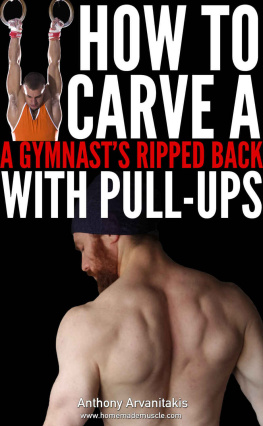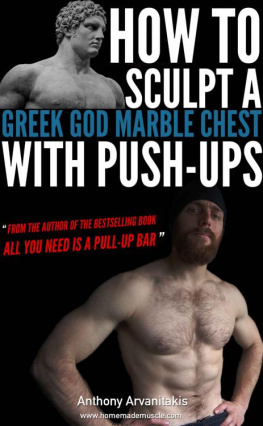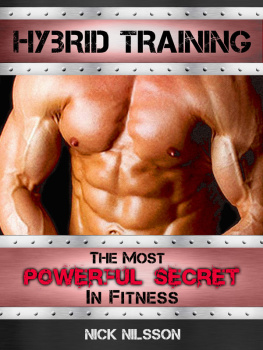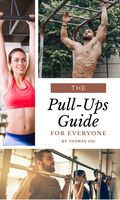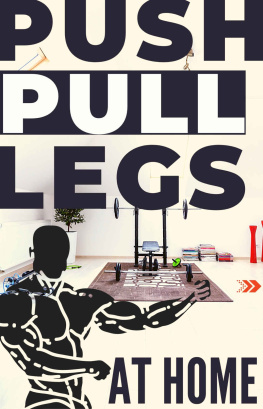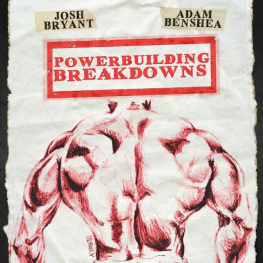This information in this book is presented with good intentions. You must always consult your physician prior to starting any exercise program, especially if you have any medical condition or injury that contraindicates physical activity. All forms of exercise pose some inherent risks. You must take full responsibility for your safety and know your limits. Before practicing the exercises in this book, make sure that any kind of equipment or surface you train on is well maintained. Do not take risks beyond your level of experience, aptitude, training and fitness. If you experience any acute or chronic pain, consult a physician. This publication is intended for informational use only and I will not assume any liability or be held responsible for any form of injury by the utilization of this information.
Thank you for showing me the value of integrity and hard work.
INTRO
Pull-ups are the king of all upper body exercises. Most gym rats would envy the sculpted backs of top-level gymnasts and canoe kayakers. Being a canoe kayaker in my early twenties, I know from personal experience that 95% of all top athletes in this sport do a massive amount of pull-ups every week. Elite organizations such as army special forces, SWAT teams, the marines and more, all require a minimum amount of pull-ups as a prerequisite for anyone to be allowed in their training programs. That's no coincidence... There is no better exercise to determine one's relative and functional upper-body strength.
"Pull-ups are the best bodyweight exercise to determine one's relative and functional strength"
Unfortunately, a big percentage of the general population is unable to perform a proper pull-up (probably not even if it were to save our own lives). After all, if you're a human being, your shoulders, arms and whole body is designed to brachiate. It's just how our anatomy has been forged through hundreds of thousands of years in order to survive and thrive. Originally, most of our back muscles were involved in making our remote ancestors walk on all fours - pulling on the ground with their forelegs (arms) in order to propel themselves forward. Once we transitioned to an upright walking style, these muscles became specialized in vertical movement, such as tree climbing . Unfortunately, we've reached a day and age were these muscles simply atrophy, as we spend a large amount of our days in a seated position. This book is also a call of action to get you off that chair and evolve by devolving again.
How's it hanging?
Just by hanging on a pull up bar, you're already doing something good for your body. One health benefit, for example, is that hanging stretches the arch of the ligament and bone covering the rotator cuff and sub acromial bursa (CA arch). Hanging, if done strategically, can remodel and reshape the shoulder bones and ligaments.
In simple words: this can help restore lost shoulder flexibility, and increase the " roomy-ness" in your shoulder (which can be decreased in issues such as shoulder impingement).
Doctor John M. Kirsch, in his amazing book " Shoulder Pain? The Solution & Prevention " talks about all these benefits when it comes to hanging for shoulder health. After 28 years of research he demonstrates how this simple exercise can help relieve shoulder issues like sub acromial impingement syndrome, rotator cuff injury or frozen shoulder. In some situations, he shows how it can prevent shoulder surgery! If you do have any of these issues with your shoulders, I highly recommend you read Doctor John M. Kirsch's book for information on how to properly implement hanging in your daily routine.
Do what is right, not what is easy...
Why is it then that if you visit a regular local gym, you'll see people lining up to use the lat pull down machine while maybe just one lone ranger will be toiling away on the pull up bar. Well, it's simple.. people always prefer the easy way out. You can cheat your way through a lot of weight with machines such as the lat pull down, using momentum, your lower back etc. but the pull-ups leave very little space for cheating. This doesn't mean that learning how to perform the exercise perfectly isn't important. On the contrary, it's those details in form and mind to muscle connection that will make all the difference if you want to strive for excellence and great results. Once you learn how to do pull-ups the right way, and as a result of that you start reaping the results that follow, you'll never look back again.

PART 1 - MIND TO MUSCLE CONNECTION
Mind to Muscle Connection
There used to be two camps when it came to the mind-muscle connection (activating a muscle mentally when training). Those who believed in it (usually people from the bodybuilding community), and those who believed that doing an exercise with good form is enough for the right muscles do their job automatically (usually people from a more science oriented background). Thankfully, we now live in a great and more unbiased time for exercise science. Thanks to people from the scientific community with more open minds, who also practice what they preach (instead of just sitting in white lab coats and talking theory). It used to be that people like Bruce Lee and Arnold Schwarzenegger used to talk a lot about this stuff, but their theories were considered more "broscience" than actual science.
(Broscience is the predominant brand of reasoning in bodybuilding circles, where the anecdotal reports of jacked dudes are considered more credible than scientific research.)
But nowadays, thanks to people like Bret Contreras and Brad Schoenfeld, these approaches are starting to be embraced by more and more people from both camps. Using scientific methods like EMG studies, we are starting to see that an activating a muscle mentally while strength training does play a big role in getting a deeper contraction of that muscle. Some people at his point might be thinking "Wow, focusing on the muscle you train leads to more efficient development of the muscle, what a discovery, bro. Do you even have to point this out?!" And yeah, I agree that it's not like a huge revelation. If you think about it, it's common sense. Optimizing the activation of neurotransmitters and synapses required for optimal muscle recruitment increases maximum muscle contraction for muscle growth. Or in simple words:
Since your mind controls your body, increased muscle activation is possible with increased focus. Therefore, instead of just doing the rep in a disengaged manner, concentrating on the targeted muscles while performing the rep can lead to more muscle gains!
The problem is that a lot of us learn to become detached from our bodies as I discussed in my interview with motivational strongman Mike Gillette. And even if we do know and understand all of this theory, most of us forget to practice it.
Understanding proper use of mind-muscle connection
The mind-muscle technique discussed in this book isn't an athletic; but a hypertrophy oriented method. Simply said, it's not going to help you do more reps or lift more weight. On the contrary, it will make the exercise you apply it on, more difficult to perform. Because, if you want to build muscle more efficiently with bodyweight exercise, you have to teach your neuromuscular system to recruit as much muscle fibers as possible. This mean that not only will you get better activation of your muscles, you will also experience your workout on a deeper level. Developing the mind-muscle connection is also about self-mastery. It's about learning to reach your utmost potential by using your mind to control your body.

